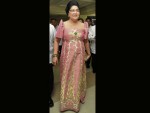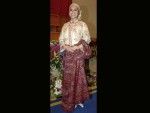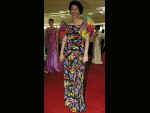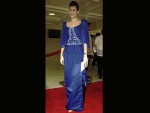 If you turned on the TV or went online last Monday, you might have been visually assaulted by the huge turnout of ternos at the State of the Nation Address (Sona).
If you turned on the TV or went online last Monday, you might have been visually assaulted by the huge turnout of ternos at the State of the Nation Address (Sona).
The Filipiniana costume came in every conceivable guise and design, from every color in a “bahaghari” (rainbow) to some resembling the color wheel of the “sapin-sapin” (with apologies to the delicious sapin-sapin).
Draped, pleated, beaded, embroidered, a la serpentina or ostrich-feathered, the terno show last Monday was “halo-halo,” if not a “puto kalamay” (again, with apologies to the…)
Senators and congresswomen looked like a gathering of peacocks strutting their plumage on the red carpet. From stately to scary, their looks were varied.
Certainly there must be aesthetic parameters on designing and wearing the butterfly-sleeved one-piece wonder, especially when worn by our legislators and national officials.
The terno is distinguished by the sharply pleated and pressed butterfly sleeves that sits on the edge of the shoulders. The sleeves really point toward the face and hair, so the wearer must keep the make-up classic and the hair swept up.
The neckline should not show cleavage. The ideal form is an A-line cut on the empire line below the bust and floor-length. This will give the wearer stature and height.
The terno is not the most comfortable design so an erect ballerina’s gait is recommended. The right silhouette is not supposed to be sexy nor slouchy. It’s supposed to be stately. That’s why the terno is usually seen and worn during the parade of contestants during international beauty contests, at the Santacruzan, and yes, state functions like the Sona.
Therefore, the wearer of the terno must have intelligent and unimpeachable taste for elegant but stately simplicity. It would help too if she knew a little of the history and the evolution of the terno.
For example, research on the golden age of Philippine fashion from the ‘40s to the ‘70s may help the wearer. Checking the fashion archives and chronicles, she will get great ideas from the designs of Pacita Longgos and National Artist for Fashion Design Ramon Valera, as well as the designs of Chrisitan Espiritu and Joe Salazar (they did the ternos of Imelda Marcos).
 If the wearer should choose a striking color, she must nix the over-embellished beadwork and embroidery. She must go to designers who excel in elegant, feminine and gracious ternos. She should avoid making a fashion statement or else she might end up a fashion victim.
If the wearer should choose a striking color, she must nix the over-embellished beadwork and embroidery. She must go to designers who excel in elegant, feminine and gracious ternos. She should avoid making a fashion statement or else she might end up a fashion victim.
It is also advisable to choose embroidered or calladoed jusi over piña, matte crepe over shiny satin or silk, for it’s best to be subtle rather than queenly.
A terno must also be age-appropriate and figure-friendly. Ladies who are wide in girth and blessed with age should consider wearing instead the baro’t saya, kimona, even the patadyong.
For accessories, it’s best to under-accessorize: no big necklaces or dangling earrings. Remember the clutch or minaudiere could make or break the over-all effect. Few women know this. No peep toe shoes and killer heels.
Reminder again: The terno should exude dignity and pride.











































